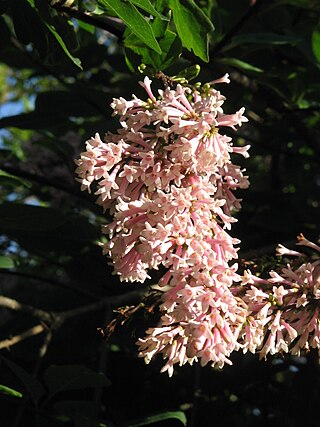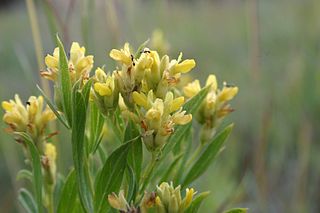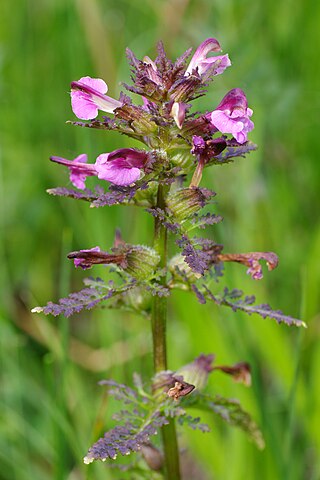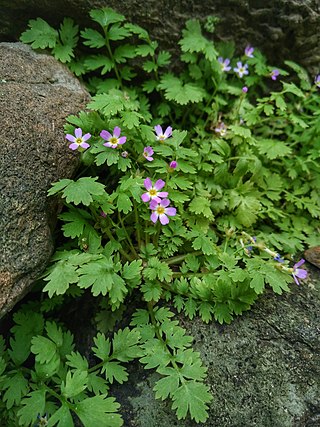
Hibiscus is a genus of flowering plants in the mallow family, Malvaceae. The genus is quite large, comprising several hundred species that are native to warm temperate, subtropical and tropical regions throughout the world. Member species are renowned for their large, showy flowers and those species are commonly known simply as "hibiscus", or less widely known as rose mallow. Other names include hardy hibiscus, rose of sharon, and tropical hibiscus.

Abelmoschus is a genus of about fifteen species of flowering plants in the mallow family (Malvaceae), native to tropical Africa, Asia and northern Australia. It was formerly included within Hibiscus, but is now classified as a distinct genus. The genus name derives from Arabic meaning 'father of musk' or 'source of musk' referring to the scented seeds.

Calystegia sepium is a species of flowering plant in the family Convolvulaceae. It has a subcosmopolitan distribution throughout temperate regions of the North and South hemispheres.

Ballota nigra, black horehound, is a perennial herb of the family Lamiaceae. It is native to the Mediterranean region and to central Asia and it can be found throughout Europe. It is also naturalized in Argentina, New Zealand, and the Eastern United States. It blooms in the Northern Hemisphere from May to August.

Cinchona officinalis is a South American tree in the family Rubiaceae. It is native to wet montane forests in Colombia, Ecuador, Peru and Bolivia, between 1600–2700 meters above sea level.

Gossypium arboreum, commonly called tree cotton, is a species of cotton native to India, Pakistan and Bangladesh and other tropical and subtropical regions of the Old World. There is evidence of its cultivation as long ago as the Harappan civilization of the Indus Valley for the production of cotton textiles. The shrub was included in Linnaeus's Species Plantarum published in 1753. The holotype was also supplied by him, which is now in the Linnean Herbarium in the Swedish Museum of Natural History.
Barbieria is a genus of flowering plants in the legume family, Fabaceae. It contains a single species, Barbieria pinnata, a climber native to the tropical Americas, from southern Mexico through Central America and the Caribbean to northern South America.
Cnidium monnieri (L.) Cusson ex Juss., Monnier's snowparsley, is a flowering plant species in the genus Cnidium. Also known as Shechuangzi, Osthole, Jashoshi, Cnidii Fructus . It may be confused with Bacopa monnieri, Ligusticum officinale, both similar but different plants. The coumarins osthol, imperatorin and xanthotoxol can be found in C. monnieri.
Sida javensis, common name in Taiwan translating as "Java golden flower noon" is a plant species apparently native to Indonesia, Malaysia, the Philippines and Taiwan, but naturalized in the West Indies and parts of Africa.
Syringa pinetorum is a species in the genus Syringa, in the family Oleaceae.

Hymenodictyon parvifolium Oliv. is a small rubiaceous African tree and is one of some 24 species in the genus, with a tropical African and Asian distribution. This species grows as a small tree to some 5 metres tall, or sometimes a liane or scrambler to 10.5 m, and is found in low-altitude woodland.

Syringa tomentella is a species in the genus Syringa, in the family Oleaceae.

Pearsonia cajanifolia is a South African shrublet belonging to the family of Fabaceae, and one of 13 species in the genus, usually herbs or shrublets with woody rootstocks and all occurring in Africa south of the equator with the exception of 1 species found on Madagascar. P. cajanifolia is commonly found in submontane grassland, at altitudes 1350–2100 m, in the South African provinces of Free State, Gauteng, Limpopo, Mpumalanga, and North West, also in Zimbabwe and Malawi.

Pedicularis palustris, commonly known as marsh lousewort or red rattle, is a plant species in the family Orobanchaceae. It is native to central and northern Europe and Asia where it grows in wetlands and boggy habitats. The International Union for Conservation of Nature has assessed its conservation status as being of least concern.

Hibiscus mesnyi is a deciduous, riverine, tropical forest tree, endemic to Vietnam, in the family Malvaceae.

Veronica catenata, the pink water speedwell, is a species of flowering plant in the family Plantaginaceae. It is native to Canada, the United States, Europe, the Azores, and northern Africa. As its common name implies, it prefers growing in or near marshes, rivers, lakes and ponds.

Dianthus thunbergii is a species of flowering plant in the family Caryophyllaceae.

Dudleya cymosasubsp. cymosa is a species of succulent perennial plant in the family Crassulaceae native to California. It is the autonymous subspecies for Dudleya cymosa, and is known by the common name canyon liveforever. It is native to the California Coast Ranges, the Sierra Nevada and the Santa Monica Mountains. It is characterized by bright-yellow, orange or red flowers and broad, wide leaves. This plant is commonly found growing on rocky outcrops, talus slopes, and in shaded canyons.

Casearia tomentosa, commonly known as the toothed leaf chilla, is a species of flowering plant in the family Salicaceae, native to the Indian Subcontinent and Myanmar. It is one of 1,000 species that can be found in the Salicaeceae family. Casearia tomentosa has various phytochemical and pharmacological properties that are used in the treatment of many illnesses. It is most notable used in the treatment of seafood poisoning, diabetes, ringworm, and snake bites. Other common names include Bhari, Maun, Churcha, Sonne bethe, and Kakoli based on the region where it is found.

Primula cicutariifolia, is a species of flowering plant within the genus Primula and family Primulaceae.
















